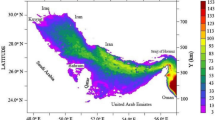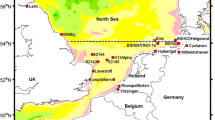Abstract
The structure and evolution of the sea breeze in the north-west part of the Mediterranean (Catalonia, north-east Spain) is studied both experimentally and, predominantly, using numerical models to increase understanding of sea-breeze structure and three-dimensional (3D) pollution distributions in coastal environments. Sea-breeze components are modelled and analyzed using the fifth-generation Pennsylvania State University–National Centre for Atmospheric Research Mesoscale Model (MM5). The results show that the growth and structure of the sea-breeze circulation is modulated by the synoptic flow and especially by the complex topography of the area. 3D pollution transport in a sea breeze is modelled by coupling the MM5 to the Community Multiscale Air Quality (CMAQ) model, with results indicating that topography and synoptic flow are the main factors modulating horizontal and vertical pollutant transport in sea-breeze episodes. In this way, horizontal dispersion is limited by the complex topography of the area, whilst the sea-breeze flow is intensified by anabatic upslope winds that contribute to vertical pollutant transport. The numerical model results also indicate that the sea-breeze circulation with a weak return flow at upper levels grows due to a synoptic onshore wind component. However, such a sea-breeze circulation is capable of transporting pollutants towards the coast.
Similar content being viewed by others
References
Arasa R, Soler MR, Ortega S, Olid M, Merino M (2010) A performance evaluation of MM5/MNEQA/CMAQ air quality modelling system to forecast ozone concentrations in Catalonia. http://cat.tethys.cat/?q=node/18
Atkins NT, Wakimoto RM (1997) Influence of the synoptic scale flow on sea breezes observed during CaPE. Mon Weather Rev 125: 2120–2130
Bastin S, Drobinski P, Dabin A, Delville P, Reitebuc O, Werner C (2005) Impact of the Rhon and Durance valleys on sea-breeze circulation in the Marseille area. Atmos Res 74: 303–328
Batchvarova E, Cai X, Gryning S-E, Steyn D (1999) Modelling internal boundary-layer development in a region with a complex coastline. Boundary-Layer Meteorol 90: 1–20
Byun DW, Ching JKS (eds) (1999) Science algorithms of the EPA models-3 community multi-scale air quality (CMAQ) modelling system. EPA report, EPA/600/R-99/030, NERL, Research Triangle Park
Cenedese A, Miozzi M, Monti P (2000) A laboratory investigation of land and sea-breeze regimes. Exp fluids 29: 291–299
Conzemius RJ, Fedorovich E (2006) Dynamics of sheared convective boundary layer entrainment. Part I: Methodological background and large eddy simulations. J Atmos Sci 63: 1151–1178
Denby B (2008) Guidance on the use of models for the European air quality directive. http://fairmode.ew.eea.europa, 113 pp
Dudhia J (1989) Numerical study of convection observed during winter monsoon experiment using a mesoscale two-dimensional model. J Atmos Sci 46: 3077–3107
Dudhia J (1996) A multi-layer soil temperature model for MM5. In: Sixth annual PSU/NCAR mesoscale model users’ workshop, Boulder, CO, July 1996, pp 49–50
Fedorovich E, Conzemius RJ (2008) Effects of wind shear on the atmospheric convective boundary layer structure and evolution. Acta Geophys 56: 114–141
Garratt JR (1990) The internal boundary layer—a review. Boundary-Layer Meteorol 50: 171–203
Garratt JR (1992) The atmospheric boundary layer. Cambridge University Press, Cambridge, 316 p
Grell G, Dudhia J, Stauffer DR (1994) A description of the fifth-generation Penn State/NCAR mesoscale model (MM5). NCAR Technical Report NCAR/TN-398+STR, National Center for Atmospheric Research, Boulder, 117 pp
Gryning S-E, Batchvarova E (1990) Analytical model for growth of the coastal internal boundary layer during onshore flow. Q J Roy Meteorol Soc 116: 187–203
Janjic ZI (1994) The step-mountain eta coordinate model. Further development of the convection, viscous sublayer, and turbulent closure schemes. Mon Weather Rev 122: 927–945
Jiménez P, Jorba O, Parra R, Baldasano JM (2006) Evaluation of MM5-EMICAT 2000-CMAQ performance and sensitivity in complex terrain: high-resolution application to the northeastern Iberian Peninsula. Atmos Environ 40(26): 5056–5072
Lapworth A (2000) Observations of atmospheric density currents using a tethered balloon-borne turbulence probe system. Q J Roy Meteorol Soc 126: 2811–2850
Lee S-M, Fernando HJS (2004) Evaluation of meteorological models MM5 and HOTMAC using PAFEX-I data. J Appl Meteorol 43: 1133–1148
Liu H, Chan JCL, Cheng AYS (2001) Internal boundary layer structure under sea-breeze conditions in Hong Kong. Atmos Environ 35: 683–692
Melas D, Lavagini A, Sempreviva A-M (2000) An investigation of the boundary layer dynamics of Sardinia Inland under sea-breeze conditions. J Appl Meteorol 39: 516–524
Miller STK, Keim BD, Talbot RW, Mao H (2003) Sea-breeze structure, forecasting and impacts. Rev Geophys 41(3): 1011
Nitis T, Kitsiou D, Klaic ZB, Prtenjak MT, Moussiopoulos N (2005) The effects of basic flow and topography on the development of the sea breeze over a complex coastal environment. Q J Roy Meteorol Soc 131: 305–327
Plant RS, Keith GJ (2007) Occurrence of Kelvin–Helmholtz billows in sea-breeze circulation. Boundary-Layer Meteorol 122: 1–15
Sha W, Kawamura T, Ueda H (1991) A numerical study on sea/land breezes as a gravity current: Kelvin–Helmholtz billows and inland penetration of the sea-breeze front. J Atmos Sci 48: 1649–1665
Simpson JE (1994) Sea breeze and local wind. Cambridge University Press, Cambridge, 234 p
Simpson JE, Mansfield DA, Milford JR (1977) Inland penetration of sea-breeze fronts. Q J Roy Meteorol Soc 103: 47–76
Soler MR, Hinojosa J, Bravo M, Pino D, Vilà Guerau de Arellano J (2004) Analyzing the basic features of different complex terrain flows by means of a Doppler sodar and a numerical model. Some implications for air pollution problems. Meteorol Atmos Phys 85: 141–154
Stull RB (1988) An introduction to boundary layer meteorology. Kluwer, Dordrecht, p 666
Talbot C, Augustin P, Leroy C, Willart V, Delbarre H, Khomenko G (2007) Impact of a sea breeze on the boundary-layer dynamics and the atmospheric stratification in a coastal area of the North Sea. Boundary-Layer Meteorol 125: 133–154
US EPA (2009) Draft guidance on meteorological model evaluation. Reassessment of the interagency workgroup on air quality modelling (IWAQM) Phase 2 summary report: revisions to Phase 2 recommendations. US Environmental Protection Agency, Research Triangle Park
Yarwood G, Rao S, Yocke M, Whitten GZ (2005) Updates to the carbon bond chemical mechanism: CB05. Prepared by ENVIRON International Corporation, Novato, for the U.S. Environmental Protection Agency, Research Triangle Park (RT-04-00675). http://www.camx.com
Author information
Authors and Affiliations
Corresponding author
Rights and permissions
About this article
Cite this article
Soler, M.R., Arasa, R., Merino, M. et al. Modelling Local Sea-Breeze Flow and Associated Dispersion Patterns Over a Coastal Area in North-East Spain: A Case Study. Boundary-Layer Meteorol 140, 37–56 (2011). https://doi.org/10.1007/s10546-011-9599-z
Received:
Accepted:
Published:
Issue Date:
DOI: https://doi.org/10.1007/s10546-011-9599-z




